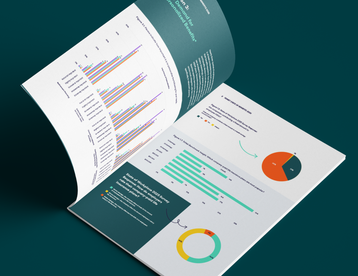Mental Health and Telehealth Take the Lead: State of Benefits 2025 for Small Business

Table of contents
- 1.The new hierarchy of benefits
- 2.Why mental health is the top priority
- 3.The Telehealth advantage
- 4.Generational insights: a shared priority with nuanced expectations
- 5.What this means for small businesses
- 6.Benefits as a strategic differentiator
- 7.Move beyond “check the box”
- 8.Address the retention gap
- 9.Integrate benefits into culture
- 10.Use data to shape next steps
- 11.Turning insight into opportunity
- 12.Conclusion: The era of holistic benefits
Employee benefits have never been more complex—or more critical—as a tool for attracting and retaining talent. The latest TriNet State of Benefits 2025* report offers a data-driven look at what employees across generations tend to value most. The findings highlight a compelling takeaway: mental health support is the number one priority across surveyed generations, followed closely by telehealth services.
For small and medium-sized businesses (SMBs), these insights aren’t just interesting—they’re strategic. Understanding what employees want from their benefits opens the door to aligning cost-effective packages that support loyalty, enhance productivity, and help set an employer apart in a competitive talent market.
The new hierarchy of benefits
Traditionally, medical, dental, and vision coverage were the cornerstones of employee benefits. While these remain essential, today’s workforce is signaling a deeper shift in priorities.
- Mental health support ranked highest in importance across Baby Boomers, Gen X, Millennials, and Gen Z.
- Telehealth access followed as the second-most important benefit.
- Other emerging areas—like bariatric treatment, chiropractic care, and holistic health—are increasingly viewed as valuable by large portions of the survey participants.
This convergence across generations is significant. Unlike voluntary benefits, which vary widely by age group (e.g., Gen Z leading in pet insurance and Millennials in income protection), mental health and telehealth are valued across generations. In other words, these benefits have become table stakes for any employer serious about retention.
While medical, dental, and vision remain essentials, employees now expect broader support—see what employee benefits include beyond the basics.
Why mental health is the top priority
The elevation of mental health benefits to the top of the list is a reflection of several long-term shifts:
- Workplace stress and burnout: Nearly every industry is grappling with rising burnout. Many employees, especially those early in their careers, are increasingly vocal about the importance of mental well-being being supported alongside physical health.
- Generational destigmatization: Each successive generation has become more open about discussing mental health. What was once considered a private issue is increasingly being recognized as a workplace priority.
- Productivity impact: Research shows that untreated mental health challenges can cost employers billions annually in absenteeism and lost productivity. Providing support is both a humanitarian and business decision.
For small businesses, this is an opportunity to differentiate culture through care. Employers who invest in accessible mental health support signal that they take employee well-being seriously, helping them stand out against competitors who may not prioritize mental health as a core part of their benefits strategy.
The Telehealth advantage
If mental health support is the “why,” then telehealth is the “how.”
Telehealth’s rise to the #2 priority reflects both convenience and cost efficient :
- Accessibility: Employees areas across different locations can gain more equal access to specialists.
- Affordability: Virtual visits typically cost less than in-person care.
- Flexibility: Busy employees—especially working parents and caregivers—value the ability to see a provider without disrupting an entire day.
For HR leaders, this is also an operational and efficiency win. Telehealth can help reduce the burden of delayed care, employees to return to work sooner, and support preventive health management—all while optimizing costs.
Generational insights: a shared priority with nuanced expectations
While mental health and telehealth are valued across generations, the report reveals generations may engage with or prioritize benefits adoption and personalization differently:
- Gen Z: More likely to experiment with non-traditional voluntary benefits (e.g., pet insurance, ID theft protection), but still rate mental health as essential.
- Millennials: Show higher overall demand for coverage breadth—including telehealth, bariatric, and holistic treatments. They’re often among the strongest supporters for flexible, tech-enabled care.
- Gen X: Prioritize retirement planning but still view mental health and telehealth as critical. They expect benefits that balance long-term financial security with immediate well-being.
- Baby Boomers: While often the lowest adopters of non-traditional benefits, they rate personalization of health coverage surprisingly high. Importantly, baby boomers in high-deductible health plans report the strongest importance ratings across all coverage categories, suggesting that cost structure can influence priorities.
For HR teams, the message is clear: mental health and telehealth are essentials, and tailoring communication by generation can make these benefits more impactful. For example, positioning telehealth as a convenience tool may resonate with Baby Boomers, while promoting app-based therapy may be more attractive to Gen Z.
What this means for small businesses
1. Benefits as a strategic differentiator
Small businesses often fear they can’t compete with enterprise-level benefit budgets. But data like these levels the playing field. Employees are not asking for extravagant perks; they want core benefits that meet today’s realities.
Mental health support and telehealth access are both scalable and cost-effective compared to many traditional benefits. Small businesses that offer them can position themselves as modern, employee-first workplaces while keeping budget considerations in mind.
Small businesses can compete effectively by offering core benefits that matter most—see how TriNet’s benefit options can help SMBs offer competitive benefit packages that attract and retain talent.
2. Move beyond “check the box”
Simply offering coverage isn’t enough. Employees value personalization—nearly three-quarters say it’s at least moderately important. This means small businesses may want to consider:
- Offering multiple plan options (PPOs, HMOs, HDHPs with HSAs).
- Providing choices within mental health support (therapy, counseling apps, EAP programs).
- Using decision-support tools to help employees elect the coverage that is best fit for their needs, rather than defaulting to the same plan year over year.
By aligning coverage with employee needs, small businesses can help optimize utilization and enhance satisfaction.
3. Address the retention gap
Retention remains one of the top challenges for SMBs. According to the report, 42% of employees simply rolled over last year’s benefits without re-evaluating, while only 15% actively consider cost-effectiveness. This inertia can signal two key concerns:
- Employees may feel disengaged from the benefits election process.
- Employers may be investing in under-valued benefits.
The solution? HR teams should take a more proactive role in benefits education—highlighting offerings, explaining the value of mental health and telehealth, and making the election process easier. Employees expect clarity on not just what benefits are offered but also when employee benefits start—a critical retention factor.
4. Integrate benefits into culture
Mental health support should not live only in a policy document. To truly resonate, benefits must be culturally embedded:
- Train managers to be aware of and support mental health.
- Normalize the use of telehealth for both routine and specialized care.
- Celebrate wellness milestones the same way companies celebrate sales or product achievements.
This not only drives utilization but reinforces the employer brand as supportive and progressive.
5. Use data to shape next steps
The State of Benefits 2025 provides benchmarks, but the real power comes when small businesses combine these insights with their own workforce data. HR departments should:
- Track enrollment and utilization by generation and role.
- Compare internal adoption rates against industry benchmarks.
- Run pulse surveys to understand evolving employee expectations.
By using data strategically, SMBs can continually refine offerings—expanding what works, phasing out what doesn’t, and staying on top of employee needs.
Turning insight into opportunity
The report’s findings are not just descriptive; they are prescriptive. For small businesses and HR teams, the top-ranked benefits reveal three opportunities:
- Talent acquisition: Promote mental health and telehealth prominently in job postings. Candidates increasingly see these as proof of a people-first culture.
- Engagement: Use benefits education campaigns to inform employees about what’s available and to feel empowered to use it.
- Retention: Refresh and personalize benefits each year to sustain interest and demonstrate responsiveness to workforce needs.
Conclusion: The era of holistic benefits
The high ranking of mental health support and telehealth across generations signals a shift in the benefits landscape. Employees no longer view these as add-ons; they see them as fundamental to modern employment.
For small businesses, this is an advantage. By focusing resources on these high-value, widely desired benefits, small businesses can compete with larger organizations, foster healthier workforces, and strengthen employee loyalty.
The takeaway for HR leaders is simple: mental health and telehealth are not trends—they are a new baseline. Small businesses that act on this now can not only meet employee expectations but also create real opportunities for growth, resilience, and long-term success. The next time you consider taking a mental health day, rest assured that the data proves you deserve it.
This article is for informational purposes only, is not legal, tax or accounting advice, and is not an offer to sell, buy or procure insurance. It may contain links to third-party sites or information for reference only. Inclusion does not imply TriNet’s endorsement of or responsibility for third-party content.

TriNet Team
Table of contents
- 1.The new hierarchy of benefits
- 2.Why mental health is the top priority
- 3.The Telehealth advantage
- 4.Generational insights: a shared priority with nuanced expectations
- 5.What this means for small businesses
- 6.Benefits as a strategic differentiator
- 7.Move beyond “check the box”
- 8.Address the retention gap
- 9.Integrate benefits into culture
- 10.Use data to shape next steps
- 11.Turning insight into opportunity
- 12.Conclusion: The era of holistic benefits






